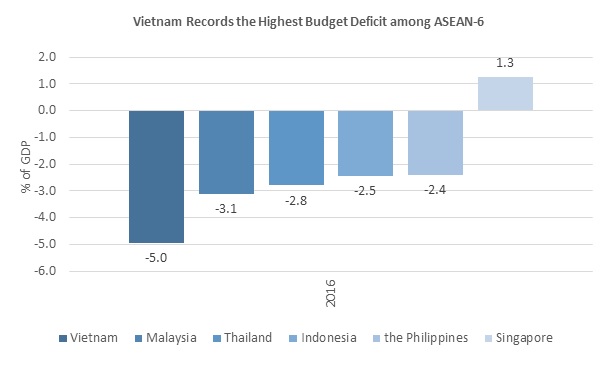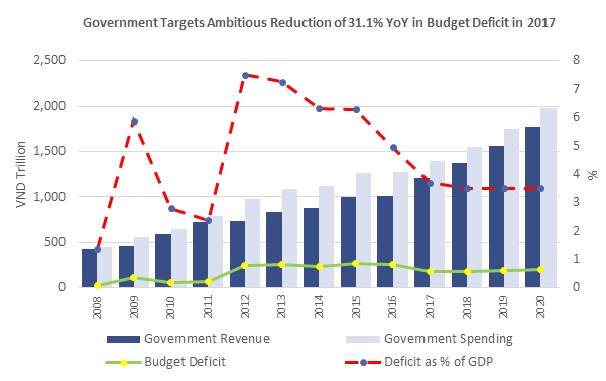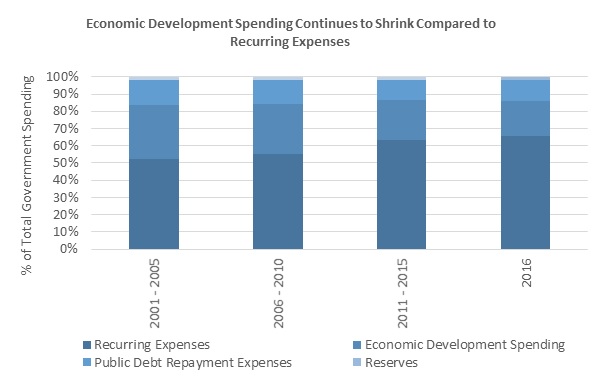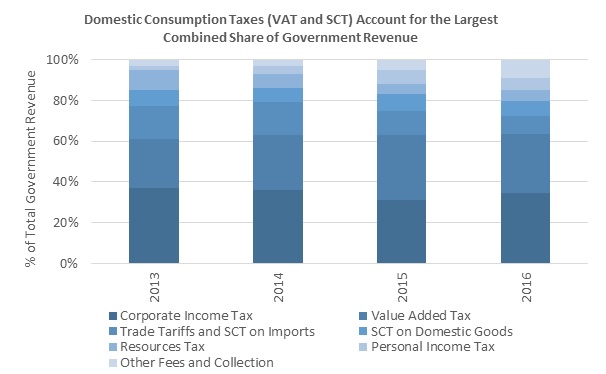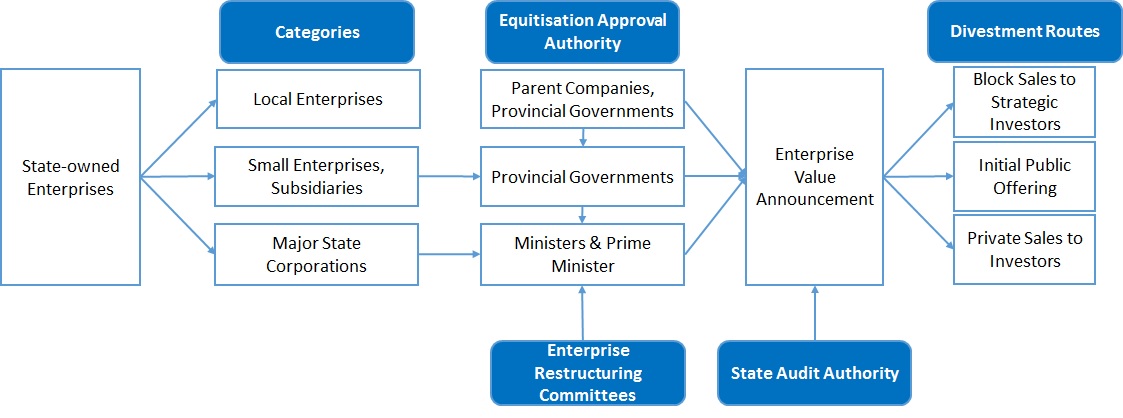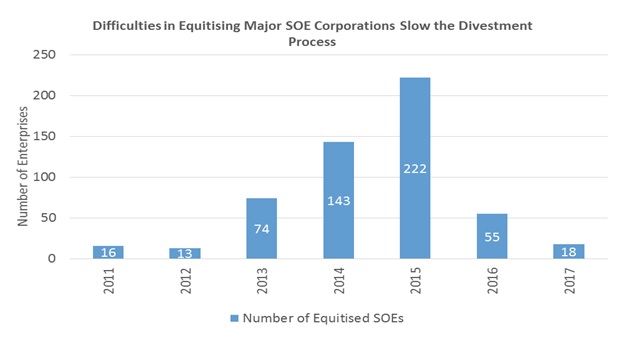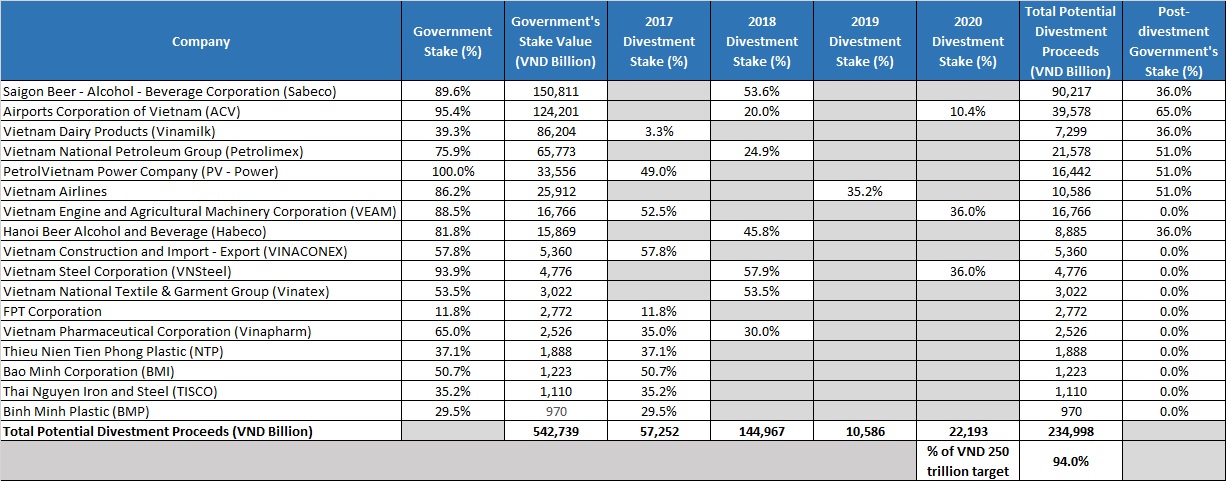Vietnam’s State-owned Enterprises Divestment Targets: Striking a Delicate Balance
|
In December 2016, the Vietnamese government issued several decrees on restructuring and divesting state-owned enterprises (SOEs) for 2016–2020. One particular decree, No. 163/2016/ND-CP, is explicit on the divestment proceeds being a source of government revenue. Even though these directives were overdue by a year, they illustrate the government’s recent aggressive push to divest several remaining major SOEs. |
|
Vietnam’s troubled state budget was a key factor in its recent acceleration of SOE restructuring and divestment. In 2016, the government targeted a budget deficit of VND 259 trillion, or 5% of GDP. Outstanding debt was just 1.3% from reaching the debt ceiling of 65% of GDP. This, combined with dwindling crude oil revenue, forced the government to (1) increase domestic tax revenue – for which the government faced immediate and severe public backlash and to (2) use SOE divestment proceeds to fund various economic development projects and other expenses. The government has been facing an increasingly difficult restructuring process in divesting major SOEs. Although 96.5% of the total 4,700 SOEs have been successfully ‘equitised’, only 8.0% of the total government ownership value in these companies has been sold to private investors. Due to their diverse business interests, complicated landholding structures, and information disclosure problems, as many as 730 equitised SOEs are yet to be listed on stock exchanges. As a result, these companies are failing to attract significant interest from private investors. The Vietnamese government targets deriving VND 250 trillion from SOE divestment for 2016–2020. As of August 2017, only 7.6% of this target has been achieved. Based on our projections, missing the divestment revenue target and the proposed tax reforms could hinder the achievement of the government’s budget deficit target (3.5% of GDP within 2018–2020 from 5.0% in 2016). The government will either have to drastically cut spending or raise its public debt ceiling. It remains to be seen how the government will strike a delicate balance between its ambitious goals. |
|
Government to Accelerate SOE Divestment as Pressure on Budget Funding Mounts On 21 December 2016, the Government of Vietnam issued Decree No. 163/2016/ND-CP to specify the types of revenue streams that the government is entitled to collect in accordance with the newly revised State Budget Law passed in 2015. Among the government revenue streams specified were proceeds from the divestment of government stakes in state-owned enterprises (SOEs), dividend income, and income received from SOEs. The new regulation thus clearly indicated for the first time that the government is allowed to use proceeds from SOE divestment as a revenue source. These proceeds are mainly to be used to (1) restructure funds at the remaining government corporations and (2) meet capital needs for infrastructure programmes, social programmes, and other government investments. In 2016, Vietnam’s targeted budget deficit, VND 259 trillion (equivalent to 5.0% of GDP), was the highest among the ASEAN-6. With total outstanding public debt at 63.7% of GDP (close to the debt ceiling of 65% of GDP) and dwindling crude oil revenue at just 5.4% of total budget revenue (versus almost 20% of total revenue in 2012), the government was relying increasingly on tax and fees collection (74.4% of total revenue) and proceeds from SOE divestment (3.0% of total revenue) to fund its various infrastructure projects and social programmes. According to projections by the Ministry of Finance, the self-imposed public debt ceiling of 65% of GDP is likely to be reached within 2017–20; this underlines the limited room there is for issuing more government bonds and government-guaranteed debt instruments used by various SOEs in the coming years to fund the budget deficit.
Source: Compiled by UZABASE based on various material
Mainly two factors have led to the government’s aggressive push to accelerate SOE restructuring and divestment. Firstly, the government targets VND 250 trillion, or VND 50 trillion per year (approximately 5% of the total annual budget in 2016), from SOE divestment proceeds to contribute to its VND 2,000 trillion (12.5%) target for economic development spend. Secondly, the government needs to cut spending at the remaining SOEs once a large majority of them become more financially independent or partially and fully privatised. Lastly, the government’s ambitious targets of keeping its budget deficit below 3.5% of GDP by 2020 and of reducing the budget deficit by 31.1% YoY in 2017 can be met only if proposals for both tax increases and SOE divestments are passed and achieve their respective targets. Source: Compiled by UZABASE based on General Statistics Office of Vietnam and Ministry of Finance
Note: 2016 and 2017 data are based on the Vietnamese government’s planned budgets
2018–20 are projections by UZABASE based on the Vietnamese government’s budget targets
Source: Ministry of Finance
Note: 2016 data is based on the Vietnamese government’s planned budget, not on actual spending
Recurring expenses include spending on ongoing social programs, government reform programs, and other administrative expenditure |
|
Proposals to Increase Taxes for Budget Funding Face Public Backlash On 17 August 2017, the Ministry of Finance announced its draft plan to revise several types of taxes including value added tax (VAT), special consumption tax (SCT), corporate income tax (CIT), and personal income tax (PIT). Under the draft proposal, the government aims to raise VAT to 12% from the current 10% by 2019. Consequently, goods and services currently enjoying a 50% VAT rebate would see their VAT rate increased to 6% from 5%. Interestingly, the proposal also includes 10% SCT on top of VAT for softdrink products except fresh juices and dairy products. Under the proposed tax reforms, the government also introduced lower CIT rates for micro-businesses (15%) and small and medium enterprises (17%) compared with the current general CIT of 20%. Special tax subsidy provisions were also proposed targeting start-ups, high-technology ventures, and agricultural businesses. Although there are legitimate budget deficit concerns to warrant several tax reforms aimed at raising tax revenue, the Vietnamese government is already facing a severe public backlash against the newly proposed increases on several consumption-related taxes such as VAT and SCT. Faced with a rising budget deficit and falling revenues from trade tariff and crude oil exports, the government has been aggressively increasing both tax rates and tax collection bases over the past ten years. Domestic collection contributed 67.6% of total revenue over 2011–15 versus just 52.2% in 2001–05. For 2016, the government budgeted for domestic tax revenue to contribute 77.4% of its total revenue. The bulk of the increase in domestic collection revenue came from increases in tax rates of VAT, SCT, and PIT, while CIT and trade tariff contribution rates declined. Source: Ministry of Finance
Note: 2016 data is based on the Vietnamese government’s planned budget, not on actual revenue
Note: Divestment returns are included in Domestic Collection
2016’s total divestment returns included in budget: VND 30,000 billion
Source: Ministry of Finance
Note: 2016 data is based on Vietnamese government’s planned budget, not on actual revenue
Note: Divestment returns are included in Domestic Collection
2016’s total divestment returns included in budget: VND 30,000 billion |
|
Vietnamese Government’s Budget and Debt Projections for 2018–20
Source: Projected by UZABASE based on the Vietnamese government’s announcements on budget and debt targets
Note: 2016 and 2017 data are the Vietnamese government’s targets
2018–20 data are UZABASE’s projections based on various government targets
Deficits for 2016 and 2017 are partially funded by the previous years’ transfer and provincial governments |
|
Using the government’s GDP growth-rate target, the public debt ceiling level, budget deficit targets, and several other budget annoucements, we project the overall budget deficit levels as well as the maximum annual permitted public debt increase for 2018–20. In 2016, the Vietnamese government approved VND 247,200 billion, VND 172,300 billion, and VND 186,900 billion worth of additional borrowings to fund the budget deficits for 2016, 2017, and 2018 respectively. Assuming a nominal GDP growth rate of 6.5% YoY for 2018–20 and assuming that the public debt ceiling (65% of GDP) is reached in 2018, the maximum annual increase in public debt would be 6.5% YoY if the government is to avoid breaching the debt ceiling. According to our projections, the differences between possible new annual public borrowings to fund the budget gap for 2018–20 should be between VND 6,000 billion and VND 7,000 billion. Given this small space within which to maneuver, the Vietnamese government will need to meet both its targets for divestment revenue as well as for tax increases. Failing this, we predict the government will be forced to either drastically cut its spending or to raise its debt ceiling of 65% of GDP. |
|
Equitisation Processes and Information Disclosure Problems Slow Divestment of Major SOEs The process of divestment of the government’s stakes in SOEs includes the highly crucial step of equitisation. According to Government Decrees 59/2011 and 189/2013, an SOE must undergo the equitisation process to become a joint stock company or a joint stock corporation. Through this process, the company’s asset, debt, and equity book values are determined and announced publicly. Concurrently, the government also announces the maximum level of ownership that it will hold at each SOE. After successful equitisations, divestment routes are determined for each enterprise, based on the feasibility of each strategy and the size of the government stakes being sold. Usually, major state corporations that have large government stakes to be divested are listed on the stock exchange. Enterprises that attract substantial interests from the private sector are then divested via private block sales to selected strategic investors, based on prior agreements on ownership levels. |
|
SOE Equitisation and Divestment Process (Simplified)
Source: Compiled by UZABASE based on Government Decrees No. 59/2011/ND-CP and No. 189/2013/ND-CP |
|
As of August 2017, 96.5% of the 4,700 SOEs have been successfully equitised since the beginning of the restructuring and divestment campaign in the late 1990s. As the equitisation campaign reached major state corporations with diverse business interests, the number of equitised SOEs declined significantly to 55 in 2016 from 222 in 2015. The complexity of determining the asset values of major corporations leads to wide differences between private investor and government valuations. Overestimates of enterprise values can result in a low level of interest from private investors, while underestimates can cause a loss of value in state assets and divestment returns. To compound the problem further, companies may be reluctant to publish full financial information, information on land holdings and investment activities, and other sensitive information for fear of prompting government inspection of potential wrongdoings. Unresolved bad loans, commercial disputes, and complicated legal commitments may also cause serious delays in equitisation. Despite the large majority of SOEs successfully equitised thus far, only 8.0% of the government’s total stake in all SOEs have been sold to private investors. There are as many as 730 equitised SOEs (around 16% of the total number of equitised SOEs) yet to be listed on stock exchanges as of August 2017. Furthermore, a large number of these unlisted equitised SOEs continue to refuse to publish full financial information and corporate information as required by the equitisation regulations. As of December 2016, only 241 of the 620 major SOEs complied with corporate information disclosure requirements. Even among these 241 SOEs, a large majority do not publish all the required information on their corporate websites. The severe lack of transparency among these SOEs has resulted in several complaints by interested private investors, especially foreign investors, to the government and the Ministry of Finance. Recently, the government published the names of the 730 SOEs that failed to list on the stock exchanges, pressuring them to disclose more information and to accelerate their IPO processes. Source: Compiled by UZABASE based on Ministry of Finance and Government Business Reform Portal
Note: 2015 data is planned equitisation numbers; actual number of equitised SOEs may differ
2017 data is as of 31 August 2017 |
|
Target Divestment Revenue for 2016–20 Threatened Total divestment returns over 2012–16 reached VND 27.5 trillion, exceeding the book value of the government ownership stake of VND 19.8 trillion by 38.8%. Divestment proceeds for 8M2017 reached VND 11.8 trillion, exceeding the book value of VND 863.8 billion by 1,267.8%. However, the jump in the divestment return followed the sale of one of the Vietnamese government’s most prized assets: shares of Vietnam Dairy Products Joint Stock Company (Vinamilk; listed): Vinamilk shares worth VND 401.2 billion in book value (equivalent to 2.87% of Vinamilk’s total equity book value) were sold for VND 11.3 trillion on the stock market. This transaction alone accounted for 95.5% of total divestment returns during the first eight months of 2017. Further divestment of 3.3% of Vinamilk shares held by the government is slated for sale later in 2017; this could generate around VND 7 trillion at the current market valuation. By the end of 2017, the government will have divested 64.0% of its total shareholdings in Vinamilk through its planned multi-year divestment process. The slow progress in divestment is clearly reflected in the significant decline in the book value of government stakes successfully sold. Only government stakes of a book value of VND 863.8 billion in SOEs have been sold by the end of August 2017, versus a peak VND 9.9 trillion divested in 2015. At the current rate, total divestment proceeds over 2016–8M2017 account for only 7.6% of the total divestment target of VND 250 trillion for 2016–20. To expedite both the equitisation of the remaining major corporations and the divestment processes, the government is expected to announce several measures to force major SOEs to list on stock exchanges as well as to disclose crucial corporate information to private and public investors. Without the successful divestment of several key state corporations such as Hanoi Beer Alcohol and Beverage (Habeco), Saigon Alcohol Beer and Beverages Corporation (Sabeco), Airports Corporations of Vietnam (ACV), and Vietnam Airlines, among others, it is unlikely that the government’s divestment target will be achieved by 2020.
Source: Compiled by UZABASE based on Ministry of Finance and various government announcements
Note: 2017 data is as of 31 August 2017 |
|
Divestment Schedule for Major SOEs and Potential Divestment Proceeds for 2017–20
Source: Calculated by UZABASE based on Information released by State Capital Investment Corporation, Ministry of Finance, and the Government of Vietnam
Note: Calculation of values based on current market prices (listed companies) and most recent divestment information (unlisted companies)
Note: Assuming Habeco divestment schedule following Sabeco’s divestment schedule |
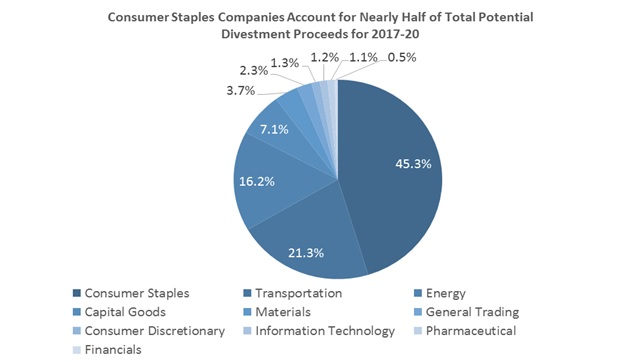 Source: Calculated by UZABASE based on Information released by State Capital Investment Corporation, Ministry of Finance, and the Government of Vietnam |




